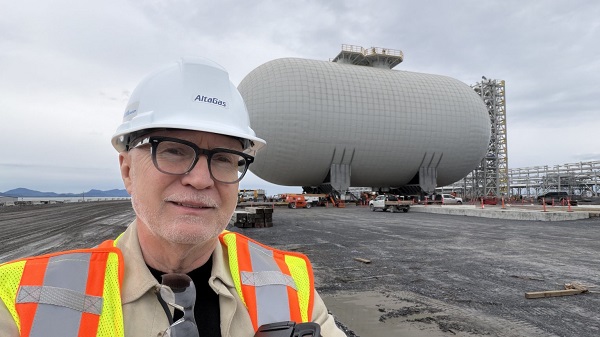Energy
Reports of the Impending Death of Petroleum Have Been Greatly Exaggerated

From EnergyNow.ca
By Jim Warren
There is a good chance climate activists smugly celebrating the collapse of conventional energy production within a generation are wildly mistaken. It is just as plausible that the time between today and ‘sunset’ for petroleum will run several decades beyond ‘net zero day’ in 2050. Actually, both predictions are suspect. History has shown people are rarely able to foresee conditions three or more decades into the future with any great precision.
Yet it seems sections of the investment community and the legacy news media assume our geopolitical future will be governed by the race to achieve net zero. They see the green transition as inevitable as death and taxes and presume oil will be sidelined accordingly.
A CBC news item that aired on March 16 boldly led with the prediction that the recently completed Trans Mountain pipeline is “likely the last new oil export pipeline the country will ever need.” The reporter was clearly caught up in a chicken and egg conundrum. He mused that due to declining production over the next decade we wouldn’t need any new pipelines. Here’s a thought, if increases in production do indeed taper off it will likely be because we can’t get enough pipelines built. Of course some CBC reporters and their fellow travellers in the climate alarmist camp never let logic get in the way of writing jubilant obituaries for the fossil fuel industries. One of the problems for conventional energy producers is that lots of people, including potential investors, have been drinking the same Kool-Aid as the media.
If the climate alarmists really have won the day, the window of opportunity is closing or has already closed on significant oil sands plant expansions, new pipelines to tidewater and any future boom in conventional oil production. After all, who wants to invest in infrastructure projects that will take a decade or more to be approved, could later be cancelled, or taxed into insolvency well before the end of their productive life spans?
No matter how long the window for viable investments remains open, one thing is clear—the Justin Trudeau government has already shortened it by a decade or more. During the eight year oil price depression that began in late 2014, new pipelines to tidewater were the one glimmer of hope for an improvement in the prices received by Canadian exporters. With more than 90,000 jobs lost in oil and gas production, manufacturing and construction by 2017, there were a lot of unemployed people in the producing provinces looking for a break. Northern Gateway, Energy East and Trans Mountain would of course allow Canadian producers to avoid the steep discounts they were subject to in the US for a significant proportion of their exports. The Trudeau Liberals cancelled any hope for that modestly brighter future.
Trans Mountain was the exception. It was the consolation prize to make up for the cancellations of Northern Gateway, Energy East and the Keystone XL. And yes, amazingly, the federal government finally got it built. It was touch and go. We were always just one bird nest away from another lengthy delay.
But wait, take heart. There is mounting evidence to suggest the hand wringing climate activists and cautious investors could have it all wrong. The goals of the green transition will probably take many more decades to achieve than they imagine.
In fact, recent events suggest the whole green transition project could actually be coming off the rails. Europe’s Green politicians are being clobbered at the polls while climate change skeptics from populist and conservative parties continue to attract voters and win elections. Green transition initiatives have been postponed and cancelled in several EU countries and the UK. The principal cause of the retreat is popular resistance to green transition initiatives that contribute to what is already an unacceptably high cost of living.
For instance, the Yellow Vests protests in France forced President Emmanuel Macron to forego a number of unpopular fuel tax measures including a carbon tax. But that wasn’t until after 11 people died and over 4,000 were injured as a result of the protests. The protests began in November 2018 and have continued sporadically to the present.
Protests by farmers in the Netherlands in 2019 beat back GHG reduction measures which would have restricted nitrogen fertilizer use and cut the national cow herd by one-half. Farmers refused to accept the assault on their incomes and plugged the country’s highways with their tractors. One of their demonstrations was reported to have caused 1000 km of traffic jams. In another protest they shut down Eindhoven airport for a day. Members of one of the more militant groups participating in the protests, the Farmers Defense Force, threatened civil war.
A new political party, the Farmer-Citizen Movement (Dutch: BBB), arose out of the Dutch farm protests. In March of 2023, the BBB won the popular vote in Netherlands’ provincial elections (they are all held on the same day) and the majority of seats in each of the country’s 12 provinces. The victory is all the more significant because the provincial governments choose who sits in the national Senate which has the power to block legislation. Protests by farmers over similar green transition projects have been occurring in France, Belgium and Germany.
The German government’s ambitious heat pump mandate had to be postponed and rethought. The ineptitude of environmentally-friendly bureaucrats who came up with the scheme was evident in the fact they still hadn’t figured out which type of heat pumps would work best under different conditions. For example, the heat pumps’ inability to operate effectively in cold weather was one of the details planners had overlooked. Additionally, they neglected to train enough technicians in heat pump installation to actually put them in people’s homes. Green politicians and their allies in government were blamed for the technical debacle and high costs for consumers. As a result, populists and likeminded conservative candidates have been defeating the Greens and Social Democrats in regional elections.
The October 2023 state elections in economically and politically powerful Hesse and Bavaria provided two of the more significant (and startling) losses in support of Germany’s three party governing coalition that includes the social democrats and the Greens. What the coalition parties lost, the right-wing populist Alternative for Germany (AfD) and conservatives won. (The Greens claim the AfD are “climate change denialists.”) The AfD is now the second largest party in terms of voter support in Hesse and the third largest in Bavaria. The online publication Energy Wire observed that the AfD platform featured concern for the flagging German economy, high energy prices, climate policy, the energy transition and immigration (in that order). More recently the Greens were the biggest losers in this May’s vote in the city state of Bremen. The Green’s 11.7% share of the vote was their poorest showing in 25 years.
Last year’s auction of UK government contracts for new offshore wind farms failed to receive a single bid. Under the auction scheme companies who purchased permits to build wind farms would receive a guaranteed premium price for the electricity they produced. The premium offered was too low to attract any interest. The Sunak government was simply not prepared to weather the consumer backlash that would accompany raising the guaranteed premium price high enough to attract bidders. Increasing the premium would require increasing electrical bills and/or taxes paid by British voters.
Melting glaciers are apparently not enough to convince some Europeans to open their wallets in support of achieving net zero. This applies even in the heart of the Alps in Switzerland. The 2020 Swiss referendum on a plan for achieving net zero GHG emissions by 2050 was soundly defeated. A significantly revised plan was later approved, but only after carbon taxes had been removed in favour of a carbon offset system and a number of other tax measures had been withdrawn. The Economist reported that one of the loudest lobby groups opposing the first referendum was the organization for Swiss resort and hotel owners. The carbon tax threatened to raise the cost of making artificial snow.
Europe’s Greens hoped to take a victory lap after recent increases in the number of solar power farms being built across Europe; especially in Germany. They have been woefully disappointed. Their promises about the thousands of new jobs that would be created by the transition to renewables proved empty and voters are not impressed. It turns out 95% of the solar systems installed in Europe are imported from Asia, mostly from China. With the exception of some local installation work, the lion’s share of the economic benefits and jobs go to Chinese firms.
No less embarrassing is the fact that one third of the essential components for Chinese solar systems are sourced from Xinjiang Province where manufacturers are known to be using forced labour. Members of the region’s Uyghur minority, who are being held prisoner in “reeducation camps,” provide the captive labour. Europe’s own solar panel producers are lobbying for relief in the form of trade restrictions on Chinese imports and/or EU subsidies. Solar system advocates in the west are between the proverbial rock and a hard place. To create the promised jobs will likely require stiff tariffs that will in turn increase the cost of solar energy and contribute to the public backlash over the already high cost of living.
Europe’s solar power dilemma echoes the French populist, Marine Le Pen’s, critique of global free trade: “Globalization is when slaves in China make things to sell to the unemployed in the west.” Le Pen came second in the last French presidential election. She has a shot at winning the next one which will be held three years from now. Le Pen is an EU skeptic who is unlikely to readily buy into its suite of exceedingly zealous GHG reduction targets and green transition policies; especially those relying heavily on foreign imports.
European auto makers have geared up their electric car production capabilities in anticipation of the EU ban on the manufacturing of new internal combustion passenger vehicles set for 2035. They are currently worried Chinese electric vehicle makers (EVs) are going to eat their lunch. The zippy little EVs made in China are far less expensive than European models. Chinese EV exports grew by 70% last year to just over $34 billion. As is the case with solar systems, the employment benefits associated with the transition to electric vehicles will be enjoyed in China not Europe. Apparently, European auto makers are frantically lobbying their governments to follow Joe Biden’s example and impose hefty tariffs on Chinese made EVs. If the car makers get their wish, jobs will be saved in Europe but the costs to European car buyers will be higher than they would be if they could buy Chinese autos. Europe’s EV problems involve the same sort of high costs versus jobs Catch 22 plaguing the EU’s solar system manufacturers. Whichever way things go, a lot of voters will be unhappy.
The growing list of failed and failing green transition initiatives is in part responsible for the surge in support for populist and conservative parties in Europe (Poland’s general election being a recent exception). And, most of Europe’s populist politicians are openly opposed to measures that increase taxes and the cost of living on behalf of combating climate change. The electoral success of the right-wing populist party, the Party for Freedom (Dutch: PVV) in the Netherlands’ November 2023 federal election is a case in point. The PVV is led by the infamous anti-immigration populist, Geert Wilders.
Wilders is not a climate change denier. He just doesn’t want to ruin the Dutch economy to combat it. Dutch environmentalists warn sea level rise caused by climate change warrants a significant reductions in GHG emissions; particularly in a country where 26% of the land is below sea level. Wilders’ solution is to just build the dikes higher.
The PVV won more seats than any other party in 2023 giving it the plurality but not a majority in the Dutch parliament. On May 16, four parties including the PVV and the Farmer-Citizen Movement (BBB) finally cobbled together a coalition government. Geert Wilders will become prime minister sometime this June. Obviously, neither the PVV or the BBB are fans of the EU’s climate change mitigation policies.
Closer to home, should Donald Trump win this November’s U.S. presidential election, progress toward net zero will virtually cease in the US for at least the next four years. And, in Canada, if current federal polling numbers hold up until Trudeau finally calls an election, we can expect the cancellation of a number of Liberal environmental initiatives; presumably, the No More Pipelines Bill and the carbon tax in particular.
The foregoing examples of recent setbacks, along with stories told by the tea leaves, indicate the road toward a green transition will be pitted with potholes and subject to roadblocks. Achieving net zero by 2050 is far from a slam dunk. Oil production is just as likely to prove far more robust than the environmental movement imagines.
Then again, if science figures out how to contain fusion reactions for extended periods of time in the next decade or so, all bets are off. Nobody knows for certain what the future holds when it comes to geopolitical conditions and energy production thirty to fifty years from today. The economist, John Maynard Keynes, claimed the only consolation for those foolishly trying accurately to predict events over the long run, was that “In the long run we are all dead.”
Energy
Canada’s future prosperity runs through the northwest coast

From Resource Works
A strategic gateway to the world
Tucked into the north coast of B.C. is the deepest natural harbour in North America and the port with the shortest travel times to Asia.
With growing capacity for exports including agricultural products, lumber, plastic pellets, propane and butane, it’s no wonder the Port of Prince Rupert often comes up as a potential new global gateway for oil from Alberta, said CEO Shaun Stevenson.
Thanks to its location and natural advantages, the port can efficiently move a wide range of commodities, he said.
That could include oil, if not for the federal tanker ban in northern B.C.’s coastal waters.

“Notwithstanding the moratorium that was put in place, when you look at the attributes of the Port of Prince Rupert, there’s arguably no safer place in Canada to do it,” Stevenson said.
“I think that speaks to the need to build trust and confidence that it can be done safely, with protection of environmental risks. You can’t talk about the economic opportunity before you address safety and environmental protection.”
Safe transit at Prince Rupert
About a 16-hour drive from Vancouver, the Port of Prince Rupert’s terminals are one to two sailing days closer to Asia than other West Coast ports.
The entrance to the inner harbour is wider than the length of three Canadian football fields.
The water is 35 metres deep — about the height of a 10-storey building — compared to 22 metres at Los Angeles and 16 metres at Seattle.
Shipmasters spend two hours navigating into the port with local pilot guides, compared to four hours at Vancouver and eight at Seattle.
“We’ve got wide open, very simple shipping lanes. It’s not moving through complex navigational channels into the site,” Stevenson said.
A port on the rise
The Prince Rupert Port Authority says it has entered a new era of expansion, strengthening Canada’s economic security.
The port estimates it anchors about $60 billion of Canada’s annual global trade today. Even without adding oil exports, Stevenson said that figure could grow to $100 billion.
“We need better access to the huge and growing Asian market,” said Heather Exner-Pirot, director of energy, natural resources and environment at the Macdonald-Laurier Institute.
“Prince Rupert seems purpose-built for that.”
Roughly $3 billion in new infrastructure is already taking shape, including the $750 million rail-to-container CANXPORT transloading complex for bulk commodities like specialty agricultural products, lumber and plastic pellets.

Canadian propane goes global
A centrepiece of new development is the $1.35-billion Ridley Energy Export Facility — the port’s third propane terminal since 2019.
“Prince Rupert is already emerging as a globally significant gateway for propane exports to Asia,” Exner-Pirot said.
Thanks to shipments from Prince Rupert, Canadian propane – primarily from Alberta – has gone global, no longer confined to U.S. markets.
More than 45 per cent of Canada’s propane exports now reach destinations outside the United States, according to the Canada Energy Regulator.
“Twenty-five per cent of Japan’s propane imports come through Prince Rupert, and just shy of 15 per cent of Korea’s imports. It’s created a lift on every barrel produced in Western Canada,” Stevenson said.
“When we look at natural gas liquids, propane and butane, we think there’s an opportunity for Canada via Prince Rupert becoming the trading benchmark for the Asia-Pacific region.”
That would give Canadian production an enduring competitive advantage when serving key markets in Asia, he said.
Deep connection to Alberta
The Port of Prince Rupert has been a key export hub for Alberta commodities for more than four decades.
Through the Alberta Heritage Savings Trust Fund, the province invested $134 million — roughly half the total cost — to build the Prince Rupert Grain Terminal, which opened in 1985.
The largest grain terminal on the West Coast, it primarily handles wheat, barley, and canola from the prairies.

Today, the connection to Alberta remains strong.
In 2022, $3.8 billion worth of Alberta exports — mainly propane, agricultural products and wood pulp — were shipped through the Port of Prince Rupert, according to the province’s Ministry of Transportation and Economic Corridors.
In 2024, Alberta awarded a $250,000 grant to the Prince Rupert Port Authority to lead discussions on expanding transportation links with the province’s Industrial Heartland region near Edmonton.
Handling some of the world’s biggest vessels
The Port of Prince Rupert could safely handle oil tankers, including Very Large Crude Carriers (VLCCs), Stevenson said.
“We would have the capacity both in water depth and access and egress to the port that could handle Aframax, Suezmax and even VLCCs,” he said.
“We don’t have terminal capacity to handle oil at this point, but there’s certainly terminal capacities within the port complex that could be either expanded or diversified in their capability.”
Market access lessons from TMX
Like propane, Canada’s oil exports have gained traction in Asia, thanks to the expanded Trans Mountain pipeline and the Westridge Marine Terminal near Vancouver — about 1,600 kilometres south of Prince Rupert, where there is no oil tanker ban.
The Trans Mountain expansion project included the largest expansion of ocean oil spill response in Canadian history, doubling capacity of the West Coast Marine Response Corporation.

The Canada Energy Regulator (CER) reports that Canadian oil exports to Asia more than tripled after the expanded pipeline and terminal went into service in May 2024.
As a result, the price for Canadian oil has gone up.
The gap between Western Canadian Select (WCS) and West Texas Intermediate (WTI) has narrowed to about $12 per barrel this year, compared to $19 per barrel in 2023, according to GLJ Petroleum Consultants.
Each additional dollar earned per barrel adds about $280 million in annual government royalties and tax revenues, according to economist Peter Tertzakian.
The road ahead
There are likely several potential sites for a new West Coast oil terminal, Stevenson said.
“A pipeline is going to find its way to tidewater based upon the safest and most efficient route,” he said.
“The terminal part is relatively straightforward, whether it’s in Prince Rupert or somewhere else.”
Under Canada’s Marine Act, the Port of Prince Rupert’s mandate is to enable trade, Stevenson said.
“If Canada’s trade objectives include moving oil off the West Coast, we’re here to enable it, presuming that the project has a mandate,” he said.
“If we see the basis of a project like this, we would ensure that it’s done to the best possible standard.”
This article originally appeared in Canadian Energy Centre
Resource Works News
Business
The world is no longer buying a transition to “something else” without defining what that is

From Resource Works
Even Bill Gates has shifted his stance, acknowledging that renewables alone can’t sustain a modern energy system — a reality still driving decisions in Canada.
You know the world has shifted when the New York Times, long a pulpit for hydrocarbon shame, starts publishing passages like this:
“Changes in policy matter, but the shift is also guided by the practical lessons that companies, governments and societies have learned about the difficulties in shifting from a world that runs on fossil fuels to something else.”
For years, the Times and much of the English-language press clung to a comfortable catechism: 100 per cent renewables were just around the corner, the end of hydrocarbons was preordained, and anyone who pointed to physics or economics was treated as some combination of backward, compromised or dangerous. But now the evidence has grown too big to ignore.
Across Europe, the retreat to energy realism is unmistakable. TotalEnergies is spending €5.1 billion on gas-fired plants in Britain, Italy, France, Ireland and the Netherlands because wind and solar can’t meet demand on their own. Shell is walking away from marquee offshore wind projects because the economics do not work. Italy and Greece are fast-tracking new gas development after years of prohibitions. Europe is rediscovering what modern economies require: firm, dispatchable power and secure domestic supply.
Meanwhile, Canada continues to tell itself a different story — and British Columbia most of all.
A new Fraser Institute study from Jock Finlayson and Karen Graham uses Statistics Canada’s own environmental goods and services and clean-tech accounts to quantify what Canada’s “clean economy” actually is, not what political speeches claim it could be.
The numbers are clear:
- The clean economy is 3.0–3.6 per cent of GDP.
- It accounts for about 2 per cent of employment.
- It has grown, but not faster than the economy overall.
- And its two largest components are hydroelectricity and waste management — mature legacy sectors, not shiny new clean-tech champions.
Despite $158 billion in federal “green” spending since 2014, Canada’s clean economy has not become the unstoppable engine of prosperity that policymakers have promised. Finlayson and Graham’s analysis casts serious doubt on the explosive-growth scenarios embraced by many politicians and commentators.
What’s striking is how mainstream this realism has become. Even Bill Gates, whose philanthropic footprint helped popularize much of the early clean-tech optimism, now says bluntly that the world had “no chance” of hitting its climate targets on the backs of renewables alone. His message is simple: the system is too big, the physics too hard, and the intermittency problem too unforgiving. Wind and solar will grow, but without firm power — nuclear, natural gas with carbon management, next-generation grid technologies — the transition collapses under its own weight. When the world’s most influential climate philanthropist says the story we’ve been sold isn’t technically possible, it should give policymakers pause.
And this is where the British Columbia story becomes astonishing.
It would be one thing if the result was dramatic reductions in emissions. The provincial government remains locked into the CleanBC architecture despite a record of consistently missed targets.
Since the staunchest defenders of CleanBC are not much bothered by the lack of meaningful GHG reductions, a reasonable person is left wondering whether there is some other motivation. Meanwhile, Victoria’s own numbers a couple of years ago projected an annual GDP hit of courtesy CleanBC of roughly $11 billion.
But here is the part that would make any objective analyst blink: when I recently flagged my interest in presenting my research to the CleanBC review panel, I discovered that the “reviewers” were, in fact, two of the key architects of the very program being reviewed. They were effectively asked to judge their own work.
You can imagine what they told us.
What I saw in that room was not an evidence-driven assessment of performance. It was a high-handed, fact-light defence of an ideological commitment. When we presented data showing that doctrinaire renewables-only thinking was failing both the economy and the environment, the reception was dismissive and incurious. It was the opposite of what a serious policy review looks like.
Meanwhile our hydro-based electricity system is facing historic challenges: long term droughts, soaring demand, unanswered questions about how growth will be powered especially in the crucial Northwest BC region, and continuing insistence that providers of reliable and relatively clean natural gas are to be frustrated at every turn.
Elsewhere, the price of change increasingly includes being able to explain how you were going to accomplish the things that you promise.
And yes — in some places it will take time for the tide of energy unreality to recede. But that doesn’t mean we shouldn’t be improving our systems, reducing emissions, and investing in technologies that genuinely work. It simply means we must stop pretending politics can overrule physics.
Europe has learned this lesson the hard way. Global energy companies are reorganizing around a 50-50 world of firm natural gas and renewables — the model many experts have been signalling for years. Even the New York Times now describes this shift with a note of astonishment.
British Columbia, meanwhile, remains committed to its own storyline even as the ground shifts beneath it. This isn’t about who wins the argument — it’s about government staying locked on its most basic duty: safeguarding the incomes and stability of the families who depend on a functioning energy system.
Resource Works News
-

 National2 days ago
National2 days agoCanada’s free speech record is cracking under pressure
-

 Energy1 day ago
Energy1 day agoTanker ban politics leading to a reckoning for B.C.
-

 Energy1 day ago
Energy1 day agoMeet REEF — the massive new export engine Canadians have never heard of
-

 Business2 days ago
Business2 days agoTaxpayers Federation calls on politicians to reject funding for new Ottawa Senators arena
-

 Fraser Institute1 day ago
Fraser Institute1 day agoClaims about ‘unmarked graves’ don’t withstand scrutiny
-

 Censorship Industrial Complex2 days ago
Censorship Industrial Complex2 days agoOttawa’s New Hate Law Goes Too Far
-

 Business2 days ago
Business2 days agoAlbertans give most on average but Canadian generosity hits lowest point in 20 years
-

 Business1 day ago
Business1 day agoToo nice to fight, Canada’s vulnerability in the age of authoritarian coercion



